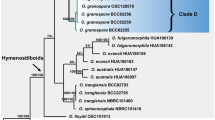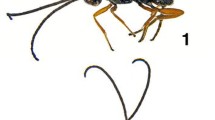Abstract
Two new Ophiocordyceps species from Thailand, which belong to Ophiocordyceps nutans species complex and attack adult and nymph of stink bugs, are described: Ophiocordyceps asiana and O. tessaratomidarum. Molecular phylogenetic analyses of ITS and a combined sequence data of LSU, RPB1 and TEF1 revealed that these two new species are distinct from other known species in Ophiocordyceps nutans species complex. Based on the findings on morphological studies, they further support the naming of these two novel species. Ophiocordyceps asiana is parasitic on adult and nymph stink bugs, members of Coreidae and Pentatomidae which were recorded from China, Japan and Thailand, while O. tessaratomidarum is reported from Thailand for the first time and is only found as a parasite on adult stink bug, Tessaratoma papillosa (Tessaratomidae, Hemiptera). The fertile heads of O. asiana are shorter than reported for O. tessaratomidarum, and the colours of fertile heads producing teleomorph of these two species differs from each other by having strong reddish orange or light yellowish pink in O. asiana and pale yellow in O. tessaratomidarum.




Similar content being viewed by others
Data availability
All sequence data generated in this study (see Table 1) are available in GenBank (https://www.ncbi.nlm.nih.gov/genbank/).
References
Araujo JPM, Evans HC, Geiser DM, Mackay WP, Hughes DP (2015) Unravelling the diversity behind the Ophiocordyceps unilateralis(Ophiocordycipitaceae) complex: three new species of zombie-ant fungi from the Brazilian Amazon. Phytotaxa 220(3):224–238. https://doi.org/10.11646/phytotaxa.220.3.2
Araujo PM, Evans HC, Kepler R, Hughes DP (2018)Zombie-ant fungi across continents: 15 new species and new combinations within Ophiocordyceps. I. Myrmecophilous hirsutelloid species. Stud Mycol 90:119–160. https://doi.org/10.1016/j.simyco.2017.12.002
Ban S, Sakane T, Nakagiri A (2015) Three new species of Ophiocordyceps and overview of anamorph types in the genus and the family Ophiocordyceptaceae. Mycol Prog 14(1):1017. https://doi.org/10.1007/s11557-014-1017-8
Friedrich RCS, Shrestha B, Salvador-Montoya C, Tomé LM, Reck M, Goes-Neto A, Drechsler-Santos E (2018)Ophiocordyceps neonutans sp. nov., a new neotropical species from O. nutans complex (Ophiocordycipitaceae, Ascomycota). Phytotaxa 344(3):215–227. https://doi.org/10.11646/phytotaxa.344.3.2
Hall TA (1999) BioEdit: a user-friendly biological sequence alignment editor and analysis program for Windows 95/98/NT. Nucleic Acids Symp Ser 41(1):95–98
Hywel-Jones N (1995) Notes on Cordyceps nutans and its anamorph, a pathogen of hemipteran bugs in Thailand. Mycol Res 99(6):724–726. https://doi.org/10.1016/S0953-7562(09)80536-4
Khonsanit A, Luangsa-ard JJ, Thanakitpipattana D, Kobmoo N, Piasai O (2019) Cryptic species within Ophiocordyceps myrmecophila complex on formicine ants from Thailand. Mycol Prog 18(1-2):147–161. https://doi.org/10.1007/s11557-018-1412-7
Kim CS, Jo JW, Kwag Y-N, Sung G-H, Lee S-g, Kim S-Y, Shin C-H, Han S-K(2015) Mushroom flora of Ulleung-gun and a newly recorded Bovista species in the Republic of Korea. Mycobiology 43(3):239–257. https://doi.org/10.5941/MYCO.2015.43.3.239
Kobayasi Y (1941) The genus Cordyceps and its allies. Science Reports of the Tokyo Bunrika Daigaku 5:53–260
Kobmoo N, Mongkolsamrit S, Tasanathai K, Thanakitpipattana D, Luangsa-ard JJ (2012) Molecular phylogenies reveal host-specific divergence of Ophiocordyceps unilateralis sensu lato following its host ants. Mol Ecol 21(12):3022–3031. https://doi.org/10.1111/j.1365-294X.2012.05574.x
Kobmoo N, Mongkolsamrit S, Wutikhun T, Tasanathai K, Khonsanit A, Thanakitpipattana D, Luangsa-ard JJ (2015) New species of Ophiocordyceps unilateralis, an ubiquitous pathogen of ants from Thailand. Fungal Biol 119(1):44–52. https://doi.org/10.1016/j.funbio.2014.10.008
Luangsa-ard JJ, Ridkaew R, Tasanathai K, Thanakitpipattana D, Hywel-Jones N (2011)Ophiocordyceps halabalaensis: a new species of Ophiocordyceps pathogenic to Camponotus gigas in Hala Bala Wildlife Sanctuary, Southern Thailand. Fungal Biol 115(7):608–614. https://doi.org/10.1016/j.funbio.2011.03.002
Luangsa-ard J, Tasanathai K, Thanakitpipattana D, Khonsanit A, Stadler M (2018) Novel and interesting Ophiocordyceps spp. (Ophiocordycipitaceae, Hypocreales) with superficial perithecia from Thailand. Stud Mycol 89:125–142. https://doi.org/10.1016/j.simyco.2018.02.001
Mains EB (1958) North American entomogenous species of Cordyceps. Mycologia 50:169–222. https://doi.org/10.1080/00275514.1958.12024722
Mongkolsamrit S, Luangsa-ard JJ, Spatafora JW, Sung GH, Hywel-Jones NL (2009) A combined ITS rDNA and beta-tubulin phylogeny of Thai species of Hypocrella with non-fragmenting ascospores. Mycol Res 113:684–699. https://doi.org/10.1016/j.mycres.2009.02.004
Mongkolsamrit S, Noisripoom W, Thanakitpipattana D, Wutikhun T, Spatafora JW, Luangsa-ard J (2018) Disentangling cryptic species with isaria-like morphs in Cordycipitaceae. Mycologia 110(1):230–257. https://doi.org/10.1080/00275514.2018.1446651
Mongkolsamrit S, Noisripoom W, Arnamnart N, Lamlertthon S, Himaman W, Jangsantear P, Samson RA, Luangsa-ard JJ (2019) Resurrection of Paraisaria in the Ophiocordycipitaceae with three new species from Thailand. Mycol Prog 18(9):1213–1230. https://doi.org/10.1007/s11557-019-01518-x
Mongkolsamrit S, Khonsanit A, Thanakitpipattana D, Tasanathai K, Noisripoom W, Lamlertthon S, Himaman W, Houbraken J, Samson RA, Luangsa-ard J (2020) Revisiting Metarhizium and the description of new species from Thailand. Stud Mycol 95:171–251. https://doi.org/10.1016/j.simyco.2020.04.001
Nikoh N, Fukatsu T (2000) Interkingdom host jumping underground: phylogenetic analysis of entomoparasitic fungi of the genus Cordyceps. Mol Biol Evol 17(4):629–638. https://doi.org/10.1093/oxfordjournals.molbev.a026341
Page RD (1996) TreeView: an application to display phylogenetic trees on personal computers. Comput Appl Biosci 12(4):357–358. https://doi.org/10.1093/bioinformatics/12.4.357
Patouillard MN (1887) Contribution a l’e’tude des champignons extra-europe’ens. Bull Soc Mycol Fr 3:119–131
Paul JS, Jadhav SK, Quraishi A, Naik ML (2020) Ferret out a natural bio-pesticide: Ophicordyceps nutans in Central India and its interaction analysis with tree stink bug. Proc Zool Soc 73(3):316–319. https://doi.org/10.1007/s12595-020-00328-4
Petch T (1939) Notes on enthomogenous fungi. Trans Br Mycol Soc 23:127–148
Ronquist F, Teslenko M, van der Mark P, Ayres DL, Darling A, Höhna S, Larget B, Liu L, Suchard MA, Huelsenbeck JP (2012) MrBayes 3.2: efficient Bayesian phylogenetic inference and model choice across a large model space. Syst Biol 61(3):539–542. https://doi.org/10.1093/sysbio/sys029
Saltamachia SJ, Araújo JPM (2020)Ophiocordyceps desmidiospora, a basal lineage within the “Zombie-Ant Fungi” clade. Mycologia 112(6):1171–1183. https://doi.org/10.1080/00275514.2020.1732147
Samson RA, Evans HC (1975) Notes on entomogenous fungi from Ghana. 3. The genus Hymenostilbe. Proceedings, Koninklijke Nederlandse Akadamie van Wetenschappen (Series C) 78:73–80
Sanjuan TI, Franco-Molano AE, Kepler RM, Spatafora JW, Tabima J, Vasco-Palacios AM, Restrepo S (2015) Five new species of entomopathogenic fungi from the Amazon and evolution of neotropical Ophiocordyceps. Fungal Biol 119(10):901–916. https://doi.org/10.1016/j.funbio.2015.06.010
Sasaki F, Miyamoto T, Yamamoto A, Tamai Y, Yajima T (2008) Morphological and genetic characteristics of the entomopathogenic fungus Ophiocordyceps nutans and its host insects. Mycol Res 112:1241–1244. https://doi.org/10.1016/j.mycres.2008.04.008
Sasaki F, Miyamoto T, Yamamoto A, Tamai Y, Yajima T (2012) Relationship between intraspecific variations and host insects of Ophiocordyceps nutans collected in Japan. Mycoscience 53(2):85–91. https://doi.org/10.1007/S10267-011-0137-0
Schoch CL, Seifert KA, Huhndorf S, Robert V, Spouge JL, Levesque CA, Chen W, Bolchacova E, Voigt K, Crous PW, Miller AN, Wingfield MJ, Aime MC, An KD, Bai FY et al (2012) Nuclear ribosomal internal transcribed spacer (ITS) region as a universal DNA barcode marker for Fungi. Proc Natl Acad Sci U S A 109(16):6241–6246. https://doi.org/10.1073/pnas.1117018109
Shrestha B, Sung JM (2005) Notes on Cordyceps species collected from the Central Region of Nepal. Mycobiology 33(4):235–239. https://doi.org/10.4489/MYCO.2005.33.4.235
Shrestha B, Tanaka E, Hyun MW, Han JG, Kim CS, Jo JW, Han SK, Oh J, Sung GH (2016) Coleopteran and Lepidopteran hosts of the entomopathogenic genus Cordyceps sensu lato. J Mycol 2016:7648219. https://doi.org/10.1155/2016/7648219
Stamatakis A (2014) RAxML version 8: a tool for phylogenetic analysis and post-analysis of large phylogenies. Bioinformatics 30(9):1312–1313. https://doi.org/10.1093/bioinformatics/btu033
Stensrud O, Hywel-Jones NL, Schumacher T (2005) Towards a phylogenetic classification of Cordyceps: ITS nrDNA sequence data confirm divergent lineages and paraphyly. Mycol Res 109(Pt 1):41–56. https://doi.org/10.1017/S095375620400139X
Sung GH, Hywel-Jones NL, Sung JM, Luangsa-ard JJ, Shrestha B, Spatafora JW (2007) Phylogenetic classification of Cordyceps and the clavicipitaceous fungi. Stud Mycol 57:5–59. https://doi.org/10.3114/sim.2007.57.01
Tasanathai K, Noisripoom W, Chaitika T, Khonsanit A, Hasin S, Luangsa-ard J (2019) Phylogenetic and morphological classification of Ophiocordyceps species on termites from Thailand. MycoKeys 56:101–129. https://doi.org/10.3897/mycokeys.56.37636
Tasanathai K, Thanakitpipattana D, Himaman W, Phommavong K, Dengkhhamounh N, Luangsa-ard J (2020)Three new Ophiocordyceps species in the Ophiocordyceps pseudoacicularisspecies complex on Lepidoptera larvae in Southeast Asia. Mycol Prog 19(10):1043–1056. https://doi.org/10.1007/s11557-020-01611-6
Thanakitpipattana D, Tasanathai K, Mongkolsamrit S, Khonsanit A, Lamlertthon S, Luangsa-ard JJ (2020) Fungal pathogens occurring on Orthopterida in Thailand. Persoonia 44:140–160. https://doi.org/10.3767/persoonia.2020.44.06
Vu D, Groenewald M, de Vries M, Gehrmann T, Stielow B, Eberhardt U, Al-Hatmi A, Groenewald JZ, Cardinali G, Houbraken J, Boekhout T, Crous PW, Robert V, Verkley GJM (2019)Large-scale generation and analysis of filamentous fungal DNA barcodes boosts coverage for kingdom fungi and reveals thresholds for fungal species and higher taxon delimitation. Stud Mycol 92:135–154. https://doi.org/10.1016/j.simyco.2018.05.001
Xiao Y-P, Wen T-C, Hongsanan S, Sun J-Z, Hyde KD (2017) Introducing Ophiocordyceps thanathonensis, a new species of entomogenous fungi on ants, and a reference specimen for O. pseudolloydii. Phytotaxa 328(2):115–126. https://doi.org/10.11646/phytotaxa.328.2.2
Zha LS, Huang SK, Xiao YP, Boonmee S, Eungwanichayapant PD, McKenzie EHC, Kryukov V, Wu XL, Hyde KD, Wen TC (2018) An evaluation of common Cordyceps(Ascomycetes) species found in Chinese markets. Int J Med Mushrooms 20(12):1149–1162. https://doi.org/10.1615/IntJMedMushrooms.2018027330
Acknowledgements
We are indebted to the Department of National Parks, Wildlife and Plant Conservation for their cooperation and support of our research project. We are also grateful to Heads of Phukhiao Wildlife Sanctuary, Phu Wiang National Park and Khao Yai National Park, and Mr. Sangaon Veeraping, the village headman of Ban Phaothai Community Forest, Phitsanulok province. We would like to thank the two anonymous reviewers and editors whose suggestions and comments helped to improve the manuscript.
Funding
This research was supported by the Platform Technology Management Section, National Center for Genetic Engineering and Biotechnology (BIOTEC), Grant No. P19-50231, the Research Personnel Development Division Central Office (NSTDA). Young Scientist and Technologist Program (YSTP) provided scholarships for W. Pooissarakul and S. Khao-ngam (Grant No. SCA-CO-2559-2421-TH and SCA-CO-2560-4637-TH, respectively).
Author information
Authors and Affiliations
Contributions
The specimens in this study were collected by S. Mongkolsamrit, S. Khao-ngam, W. Pooissarakul, W. Noisripoom, W. Himaman and J. J. Luangsa-ard. Morphological data were collected by S. Khao-ngam, W. Pooissarakul and S. Mongkolsamrit. Molecular data and phylogenetic analyses were performed by W. Noisripoom, S. Khao-ngam and W. Pooissarakul. Stink bugs were identified by J. Duangthisan. The project was supervised by J. J. Luangsa-ard. The original draft was written by S. Mongkolsamrit and N. Rungjindamai and it was reviewed and edited by J. J. Luangsa-ard. All authors commented and discussed on previous versions of the manuscript. All authors approved the final manuscript and agreed its publication in Mycological Progress.
Corresponding author
Ethics declarations
Conflict of interest
The authors declare no competing interests.
Additional information
Publisher’s note
Springer Nature remains neutral with regard to jurisdictional claims in published maps and institutional affiliations.
Section Editor: Marc Stadler
Supplementary information
ESM 1
(DOCX 20 kb)
Rights and permissions
About this article
Cite this article
Khao-ngam, S., Mongkolsamrit, S., Rungjindamai, N. et al. Ophiocordyceps asiana and Ophiocordyceps tessaratomidarum (Ophiocordycipitaceae, Hypocreales), two new species on stink bugs from Thailand. Mycol Progress 20, 341–353 (2021). https://doi.org/10.1007/s11557-021-01684-x
Received:
Revised:
Accepted:
Published:
Issue Date:
DOI: https://doi.org/10.1007/s11557-021-01684-x




